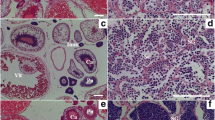Abstract
Cent percent allotriploids were induced by heat shocking (42°C for 3 min) of 2·5 min old (post-fertilization)Oreochromis mossambicus eggs fertilized with (homozygous) red tilapia milt. Control diploid hybrids were red (orange) in colour. A few triploid hybrids displayed more patches of black pigmentation. Hence red and black colours are regarded as co-dominants. Survival of the allotriploids was higher than that ofOreochromis mossambicus autotriploids.
Similar content being viewed by others
References
Arai K 1984 Developmental genetic studies on salmonids: morphogenesis, isozyme phenotypes and chromosomes in hybrid embryos;Mem. Fac. Fish. Hokkaido Univ. 31 1–94
Arai K 1986 Effect of allotriploidization on development of the hybrids between female chum salmon and male brook trout;Bull. Jpn. Soc. Fish. 52 823–829
Capanna E, Cataudella S and Volpe R 1974 Un ibrido intergenerico tra trota iridea e salmerino di fonte (Salmo gairdneri × Salvelinus fontinalis);Boll. Pesca Piscic. Idrobiol. 29 101–106
Chevassus B, Guyomard R, Chourrout D and Quillet E 1983 Production of viable hybrids in salmonids by triploidization;Genet Sel. Evol. 15 519–532
Crockrum E L and McCauley W J 1964Zoology (Philadelphia: W B Saunders)
Das P, Mukopadhyay M K, Das K M and Pandit P K 1987 Gonadal sex manipulation ofOreochromis mossambicus (Peters);Proc. World Symp. on Selection Hybridization and Genetic Engineering in Aquaculture, Bordeaux, Berlin, pp 74–78
Donaldson E M and Benfey T J 1987 Current status of induced sex manipulation;Proc. Third Int. Symp. Reproductive Physiol. Fish, Memorial Univ. of Newfoundland, St John’s, Canada, pp 108–119
Fankhauser G 1945 The effect of changes in chromosome number on amphibian development;Q. Rev. Biol. 20 20–78
Hickling C F 1963 The cultivation of Tilapia;Sci. Am. 208 143–152
Huang C M, Chang S L, Cheng H J and Liao I C 1988 Single gene inheritance of red body coloration in Taiwanese red tilapia;Aquaculture 74 227–232
Hulata G, Rothbard S and Wohlfarth G 1981 Genetic approach to the production of all-male progeny of tilapia;Eur. Maricult. Soc. Spec. Publ. 6 181–190
Hulata G, Wohlfarth G and Rothbard S 1983 Progeny-testing selection of tilapia broodstocks producing all-male hybrid progenies—preliminary results;Aquaculture 33 263–268
John G, Reddy P V G K and Gupta S D 1984 Artificial gynogenesis in two Indian major carps.Labeo rohita (Ham.) andCatla catla (Ham.);Aquaculture 42 161–168
Klingerman A D and Bloom S E 1977 Rapid chromosome preparation from solid tissues of fishes:J. Fish. Res. Board Can. 34 266–269
Lovshin L L 1982 Tilapia hybridization; inThe biology and culture of Tilapia (eds) R S V Pullin and R H Lowe-McConnel (ICLARM Symp. Proc., Manila) vol. 7, pp 279–308
Mires D 1988 The inheritance of black pigmentation inOreochromis nilotieus from two African origins; inThe Second Int. Symp. on Tilapia in Aquaculture (eds) R S V Pullin, T Bhykasawan, K Tonguthai and J L Maclean (ICLARM Conference Proc., Manila) vol. 15, pp 237–241
Pandian T J and Varadaraj K 1987 Techniques to regulate sex ratio and breeding in tilapia;Curr. Sci. 56 337–343
Pandian T J and Varadaraj K 1988 Techniques for producing all-male and all-triploidOreochromis mossambicus; inThe Second Int. Symp. on Tilapia in Aquaculture (eds) R S V Pullin, T Bhykasawan, K Tenguthai and J L Maclean (ICLARM Conference Proc., Manila) vol. 15, pp 243–249
Scheerer P D and Thorgaard G H 1983 Increased survival in salmonid hybrids by induced triploidy;Can. J. Fish. Aquat. Sci. 40 2040–2044
Streisinger G, Walker C, Dower N, Knauber D and Singer F 1981 Production of clones of homozygous diploid zebra fish (Brachydanio rerio);Nature (London) 29 293–296
Swarup H 1959 Production of triploidy inGasterosteus aculeatus;J. Genet. 56 129–142
Thorgaard G H 1983 Chromosome set manipulation and sex control in fish;Fish Physiol. B9 405–434
Thorgaard G H and Allen S K Jr 1987 Chromosome manipulation and markers in fishery management; inPopulation genetics and fishery management (eds) N Ryman and F Utter (Washington Sea Grant Program, Seattle) pp 319–331
Uyeno T 1972 Chromosomes of offspring resulting from crossing coho salmon and brook trout;J. Ichthyol. 19 166–171
Varadaraj K and Pandian T J 1988 Induction of triploids inOreochromis mossambicus by thermal, hydrostatic pressure and chemical shocks;Proc. Int. Aquaculture Cong., Vancouver, pp 531–535
Wohlfarth G W and Hulata G I 1983Applied genetics of tilapias, Studies and reviews 6, ICLARM Manila, pp 1–26
Author information
Authors and Affiliations
Additional information
The fish is orange in colour, however it is cited as red tilapia as is commonly known.
Rights and permissions
About this article
Cite this article
Varadaraj, K., Pandian, T.J. Induction of allotriploids in the hybrids ofOreochromis mossambicus female × red tilapia male. Proc. Indian Acad. Sci. (Anim. Sci.) 98, 351–358 (1989). https://doi.org/10.1007/BF03179961
Received:
Revised:
Issue Date:
DOI: https://doi.org/10.1007/BF03179961




